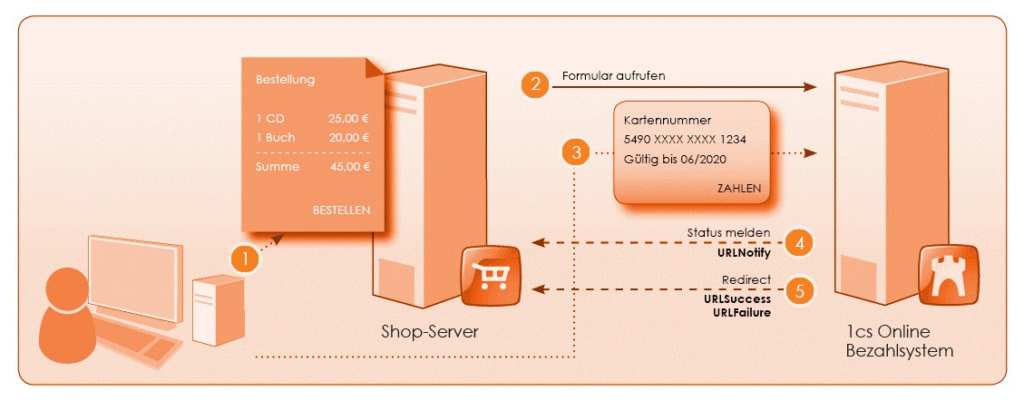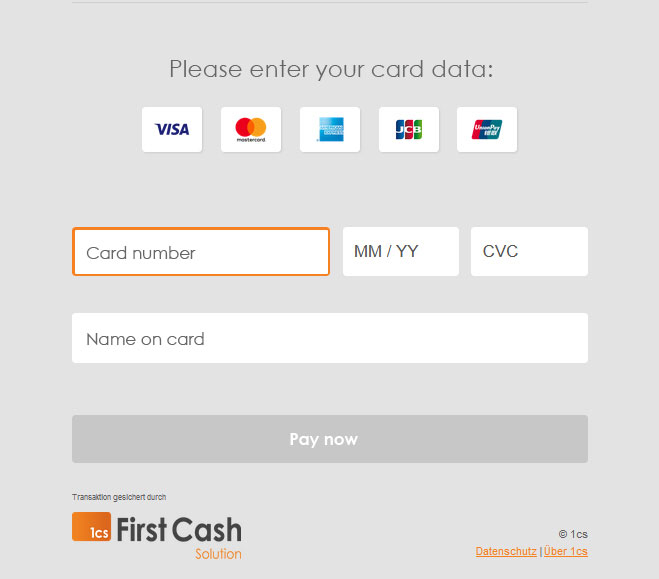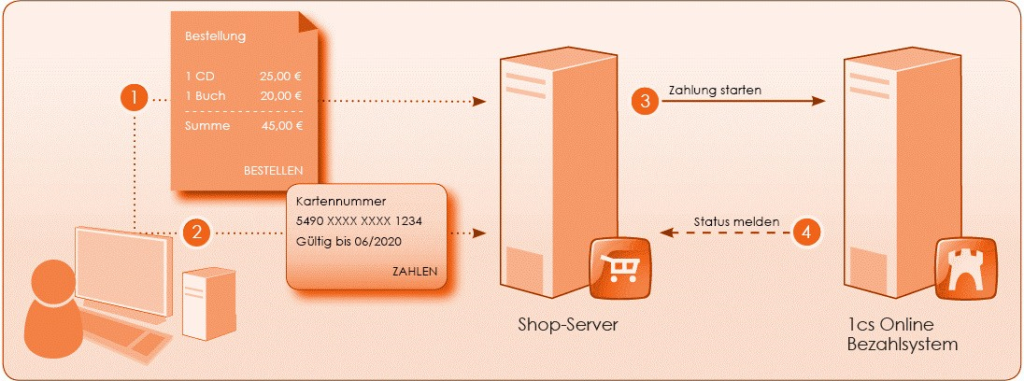Programming basics
1.1 Merchant Interface variants
1.1.1 1cs Online Payment System forms
1.1.2 Payment processing via Server-to-Server
1.1.3 Payment processing via Batch
1.2 Security: Payment Card Industry Data Security Standard (PCI DSS)
1.2.1 1cs Online Payment System HTML form
1.2.2 Server-to-Server payment
1.2.4 PayNow – the Silent Mode
1.3 Principles of 1cs Online Payment System programming
1.4 Operating principle of the Merchant Interface
2 Payments via 1cs Online Payment System forms
2.2 Request for a 1cs Online Payment System form
2.3 Hash HMAC authentication (Request)
2.4 Hash HMAC authentication (Notify)
2.6 Transfer of the customer to the shop
1 Programming
1.1 Merchant Interface variants
The 1cs Online Payment System permits three forms of online-communication with merchant-systems: the 1cs Online Payment System provides forms for entering the payment data. You can alternatively design your own forms and process payments in the background via a Server-to-Server connection between the shop and the 1cs Online Payment System server.
1.1.1 1cs Online Payment System forms
The 1cs Online Payment System provides HTML-forms with TLS-encryption. Your shop needs only request the HTML form from the 1cs Online Payment System to connect the customer to the 1cs Online Payment System for the payment. Customers then enter payment details in the 1cs Online Payment System HTML form which uses a First Cash Solution SSL certificate. the 1cs Online Payment System makes the payment and informs the shop about the transaction status (URLNotify, URLSuccess, URLFailure). Forms require the least programming input.

One advantage is that credit card data and account connections are saved only on the 1cs Online Payment System-server. This exempts you from the security regulations such as PCI DSS (Payment Card industry Data Security Standard) because no credit card data is saved in the shop. See below for an explanation of PCI DSS.

The 1cs Online Payment System forms can be configured in multiple languages and permits the individual selection of colours, images and font formats so that the page matches the layout of the shop. In addition there are designated forms for credit card transactions and SEPA direct debits which match the shop layout (see example of the Corporate PayPage: XSLT layout for forms in the corresponding handbook).
1.1.2 Payment processing via Server-to-Server
If you wish to design your own forms for entering the payment data you can process your transactions in the background via a Server-to-Server connection. In this case your system saves payment details such as credit card numbers or bank account details and then creates a TLS socket-connection to the 1cs Online Payment System Server in order to process the payment. In this variant your system controls the communication with the 1cs Online Payment System which involves more programming than with the 1cs Online Payment System forms which automatically process the payments for you.


Notice: Please note that captures, credits and status inquiries are possible only via the Server-to-Server connection or via Batch..
1.1.3 Payment processing via Batch
Batch Manager lets you transmit payment transactions in the form of files. In this process you assemble transaction data such as the transaction ID, amount and currency in a batch file which you will later transmit to the 1cs Online Payment System. the 1cs Online Payment System then makes the payments and saves the transaction status in the batch file. After processing, the merchant can access the batch file with the details on the transaction status via download.
1.2 Security: Payment Card Industry Data Security Standard (PCI DSS)
Where the credit card data is entered and stored is vital for the security of the credit card payments on the Internet. The card organisations have established a security program with the PCI security authorisation (Payment Card Industry) in order to guarantee the secure storage of credit card data. Please note that participation in PCI is compulsory and subject to a charge if you store credit card data. The key factor in this is the Merchant Interface variant:
1.2.1 1cs Online Payment System HTML form
In this case the credit card data is only saved on the secure the 1cs Online Payment System server. Optionally the 1cs Online Payment System provides you with a pseudo card number (PKN), which can be used like a real credit card number.
1.2.2 Server-to-Server payment
Credit card data is saved on your systems. Therefore you are obliged under certain circumstances to undergo the MasterCard and VISA PCI Data Security program which is associated with annual authorisation costs and time. You can obtain further details from your credit card acquirer.

Notice: Please note that Visa and MasterCard have established strict security regulations for the protection of credit card data. Anyone who saves credit card numbers on their system or even only transmits such data must undergo –at their own expense – regular security authorisation. You should therefore use the 1cs Online Payment System forms. If you require credit card numbers for recurrent subscription payments, the 1cs Online Payment System lets you use a pseudo card number which you can substitute for the real credit card number for authorisations, captures and credits.
1.2.3 Batch
Payment data can be submitted as Batch file to the 1cs Online Payment System. In this case there are the two variants via the SFTP protocol and per HTTPS via the merchant backoffice in Merchant Cockpit. Within batch processing not alle functions are available which are usually available for the online interface.
1.2.4 PayNow – the Silent Mode
With the PayNow solution the customer enters the data analogue as for the Server-to-Server solution but with the essential difference, that credit card data are transferred directly from the browser (client) to First Cash Solution. Above all this saves a lot of effort in the case of complex 3D methods such as Verified by Visa, MasterCard SecureCode and American Express SafeKey. For more details about the PayNow solution see the card processing manual. In order to use this interface the merchant must fulfil the PCI requirement according to SAQ A-EP (https://www.pcisecuritystandards.org/documents/PCI-DSS-v3_2-SAQ-A_EP-rev1_1.pdf).
1.3 Principles of 1cs Online Payment System programming
The Merchant Interface is designed to accept transactions across the Internet. This interface can be used not only by shops but also by enterprise resource planning systems, for example to initiate payment capture via the 1cs Online Payment System after shipment of goods.
To ensure compatibility with programming languages and operating systems, the 1cs Online Payment System eliminates the need for complex software on the shop server because software installation generally causes problems with operating system versions or safety regulations. Instead, you need only send data via HTML to the 1cs Online Payment System – it works in any programming language on any operating system.
Communication with the 1cs Online Payment System takes place via TCP/IP and HTTP (HyperText Transmit Protocol) with 128 bit TLS-encryption (HTTPS). Depending on the payment method, a particular Internet page is requested in order to carry out a transaction:
In this homogenous interface, irrespective of the payment method, the same parameters are transmitted in general to these Internet pages so that all payment methods operate in the same way and require no additional effort.
The most important parameters to be submitted to the 1cs Online Payment System Internet pages are:
- MerchantID
- Amount and Currency
- URLs for status-messages
The MerchantID is an alphanumerical value which uniquely identifies the merchant within the 1cs Online Payment System and is allocated by First Cash Solution. The Amount and Currency parameters determine the amount of the payment. You also give an Internet page for your shop which receives the result of the payment: After making the payment, the 1cs Online Payment System confirms successful payments by calling up URLSuccess and failed payments by calling up URLFailure.
The following list shows a typical example with the parameters for processing a payment:
MerchantID=YourMerchantID&TransID=ab123456&Amount=9000&Currency=EUR&URLSuccess=https://www.shop.de/ok.cgi&URLFailure=https://www.shop.de/failed.cgi&URLNotify=https://www.shop.de/notify.cgi

Notice: Depending on the implementation, URLSuccess and URLFailure are called up via a Redirect (HTTP Status 302 Object Moved) which is then dependent on the customer’s browser. In order to ensure that the shop has been informed correctly about the status of the payment the 1cs Online Payment System sends a further confirmation via a direct Server-to-Server connection to the shop (URLNotify).
Operating principle of the Merchant Interface
In order to send payment orders to the Paygate Merchant Interface a shop connects via Internet to Paygate and sends the required payment data in a defined homogeneous format which is based on name-value-pairs (NVP). The Paygate Merchant Interface works with HTML and is compatible with all current firewalls, operating systems (Linux, Unix, Windows) and shop systems. Even self-programmed shops can be simply integrated with the Paygate interface.
A payment process looks something like the following:
1. The customer selects the payment method in the shop and clicks on the Pay button.
2. The shop generates a character string with merchant number, amount and shopping cart.
3. Depending on the payment method the character string is transmitted to the corresponding Internet page.
The simple transmission of a character string has the advantage that you need install no software on the shop server. The interface functions with all current payment methods so that a connection to Paygate suffices for several payment methods.
1.4 Operating principle of the Merchant Interface
In order to send payment orders to the 1cs Online Payment System Merchant Interface a shop connects via Internet to the 1cs Online Payment System and sends the required payment data in a defined homogeneous format which is based on name-value-pairs (NVP). The 1cs Online Payment System Merchant Interface works with HTML and is compatible with all current firewalls, operating systems (Linux, Unix, Windows) and shop systems. Even self-programmed shops can be simply integrated with the 1cs Online Payment System interface.
A payment process looks something like the following:
1. The customer selects the payment method in the shop and clicks on the Pay button.
2. The shop generates a character string with merchant number, amount and shopping cart: “MERCHANT=YourMerchantID&AMOUNT=49&SHOPPING CART=Flowers”
3. Depending on the payment method the character string is transmitted to the corresponding Internet page: https://www.computop-paygate.com/paySSL.aspx?”MERCHANT=123&Amount=49&SHOPPING CART=Flowers”
The simple transmission of a character string has the advantage that you need install no software on the shop server. The interface functions with all current payment methods so that a connection to the 1cs Online Payment System suffices for several payment methods.
2 Payments via 1cs Online Payment System forms
In the case of payments via the 1cs Online Payment System forms, the shop redirects its customers to the 1cs Online Payment System HTML form where they enter their payment details. the 1cs Online Payment System then processes the payment and informs the shop about the payment result.

2.1 Payment process
To make payments via the 1cs Online Payment System forms you send a request to a the 1cs Online Payment System Internet page with HTTPS GET or HTTPS POST. The corresponding URL you will find within the manual for the respective payment method.
All details required for payment processing are forwarded as parameters. The parameters are encrypted with Blowfish and protected with HMAC-Authentication (see below) to ensure that neither the customer nor a third party can manipulate the data.
When calling the form, the 1cs Online Payment System decrypts the parameters and shows the HTML page with the entry fields for the corresponding payment type. The customer enters the data and triggers the payment process by clicking the Pay button.
After the payment has been made the 1cs Online Payment System redirects the customers back to a shop page via HTTPS GET (URLSuccess, URLFailure) and transmits the result of the payment as a Blowfish-encrypted parameter string to these URLs. In addition, the 1cs Online Payment System transmits the result via HTTPS POST to the shop’s Notify page (URLNotify). The shop accepts the payment result and decrypts the data in order to inform the customer about the status.
2.2 Request for a the 1cs Online Payment System form
The request for a the 1cs Online Payment System form starts with the correct composition of the parameters which consist of a key and a value which are separated by an equals sign (=). These are so called Name-Value-Pairs (NVP):
MerchantID=YourMerchantID
All parameters are assembled in a character string and separated by the character &:
Amount=100&Currency=EUR&TransID=12345

Notice: Since the characters “=” and “&” are used as separating characters, these characters cannot be transmitted as values. All values which you transmit without BlowFish-encryption must be URL-Encoded.
A correct parameter character string for the 1cs Online Payment System contains three basic parameters: MerchantID, Len and Data. The parameters MerchantID and Len are unencrypted. Only the Data parameter is Blowfish-encrypted:
MerchantID=YourMerchantID&Len=67&Data=0A67FE96a65d384350F50FF1
The Data parameter contains the sensitive payment details such as amount and currency. The encrypted bytes are Hex-encoded and completed to two characters from the left with a zero. Encryption is via Blowfish ECB and is available to you as source-code and components.
The Len parameter is very important for encryption because it contains the length of the unencrypted(!) character string in the Data parameter. Since the data quantity to be encrypted is increased by a multiple of 8 in the case of the Blowfish encryption, the correct length of the character string must be known for decryption. Otherwise accidental characters emerge at the end of the character string.
The parameters are transmitted via HTTPS POST or HTTPS GET. The recommended transmit method is HTTPS POST because the parameter character string in the case of GET is attached to the URL, which is limited to 2048 bytes depending on the browser.

Notice: Please note that the maximum length of a payment request is limited to 5120 characters. If you require longer strings please contact First Cash Solution Support.
The following listings show the development of a payment request. The first listing is the unencrypted parameter character string:
MerchantID=YourMerchantID&TransID=100000001&Amount=11&Currency=EUR&URLSuccess= https://www.shop.de/ok.html&URLFailure=https://www.shop.de/failed.html&URLNotify=https://www.shop.com/notify.cgi&OrderDesc=My purchase

Notice: Please note that a value is to be assigned to each parameter. Do not transmit empty parameters, as this can cause the payment to fail.
This character string is encrypted and transmitted as the Data parameter. The HTTPS GET request for a the 1cs Online Payment System form for credit card payments looks like this:

Notice: Please note that the parameters are transmitted unencrypted for the purpose of layout of the form.
An HTML form is produced for HTTPS POST and all parameters are transmitted as Hidden Fields. Only the Pay button is visible to the customer:
<FORM method=”POST” action=”https://www.computop-paygate.com/payssl.aspx“>
<INPUT type=”hidden” name=”MerchantID” value=”YourMerchantID”>
<INPUT type=”hidden” name=”Len” value=”162″>
<INPUT type=”hidden” name=”Data” value=”E98D40FFFD622C5FE7414F73539A1852C2CE7C8B09D34DF217E27FA2E194B9968DE9ABAE3B1F44B5485E
FE3EF2597C7395BADBAD4340CDFD000DD57129EEFAA0BE904A7E2339DCF9363DA6ACDBE5EF98E169FC3092B1602
52A037135421FD0CE092C174A7D1D63517BD45099AC2B682F5E3CD2C942A6F0E741A833C0″>
<INPUT type=”hidden” name=”Background”
value=”https://www.meinshop.de/grafik/hintergrundbild.jpg“>
<INPUT type=”submit” name=”Pay” value=”Pay”>
</FORM>
2.3 Hash HMAC-Authentication (Request)
To protect against unauthorised manipulation of your payment transactions, the 1cs Online Payment System checks with the aid of a Hash Message Authentication Code (HMAC) whether your payment enquiry is authentic and has not been manipulated. For this purpose, you transfer an HMAC value to the 1cs Online Payment System with each transaction in the parameter MAC.
Background: Unlike the HMAC procedure every encoding method has the disadvantage that there is a matching decoding method. Anyone who possesses the correct key or cracks the encryption can read and manipulate the data. Therefore, no encryption method is ever 100% safe. In the case of the Hash procedure, conversely, decoding is impossible, so that a Hash value can confirm the authenticity of the message free of doubt.
The 1cs Online Payment System uses a Hash Message Authentication Code (HMAC) to check the authenticity of your payments. The MAC SHA-256 algorithm is used with a 32-digit key length (256 bits) for this. The additional password makes the HMAC procedure particularly safe.
The following table describes how you can generate the Hash values for your payment:
| Step | Task |
| 1 | Please log on to First Cash Solution Support, which supplies you with the Hash password. |
| 2 | The HMAC value is calculated with the aid of the password and several parameter values. For the calculation, the parameters PayID, TransID, MerchantID, Amount and Currency are used and separated with asterisks: PayID*TransID*MerchantID*Amount*Currency Notice: If a transaction does not support all of these parameters, you can simply omit the missing value. For example, there is no PayID yet with the first transaction, so you do not have to transfer this. The PayID is a component of the Hash calculation in subsequent transactions: Example 1, without PayID (e.g. when authorising): *B456Ref890*YourMerchantID*9900*EUR Example 2, with PayID (e.g. when capturing): 1237890*B456Ref890*YourMerchantID*9900*EUR Example 3, without TransID: 1237890**YourMerchantID*9900*EUR |
| 3 | Use the MAC SHA-256 algorithm, which nearly all programming languages support, in order to calculate the Hash value with the password and the parameter values. |
| 4 | Use the MAC parameter to transfer the hexadecimal encoded Hash value to the 1cs Online Payment System with each transaction in the encoded data field. |

Notice: Note that the MAC parameter is obligatory for all subsequent transactions (e.g. capture, credit note) if it was transferred with the first transaction (e.g. authorisation).
Important: The 1cs Online Payment System rejects transactions with wrong or missing HMAC values promptly without further processing, because this is an indication of hacker attacks. Therefore, transactions which the 1cs Online Payment System rejects with the error codes 20100044 or 20120044 do not appear in Merchant Cockpit.
Listing with HMAC examples
Request without PayID:
MerchantID=YourMerchantID&TransID=100000001&Amount=11&Currency=EUR&URLSuccess=https://www.shop.de/ok.html&URLFailure=https://www.shop.de/failed.html&OrderDesc=My purchase
String for MAC generation:
*100000001*Test*11*EUR
Request with MAC:
MerchantID=YourMerchantID&TransID=100000001&Amount=11&Currency=EUR&URLSuccess=https://www.shop.de/ok.html&URLFailure=https://www.shop.de/failed.html&OrderDesc=My purchase&MAC=A0E3A8BB9473CF4D3F91181E0859650A9AF3F4AD0AE1E839AC7B750247A2E947
Request without TransID:
MerchantID=YourMerchantID&PayID=8ee4e922c39446ac9ee66095a4a4b475&Amount=100&Currency=USD
String for MAC generation:
8ee4e922c39446ac9ee66095a4a4b475**Test*100*USD
Request with MAC:
MerchantID=YourMerchantID&PayID=8ee4e922c39446ac9ee66095a4a4b475&Amount=100&Currency=USD&MAC=F1EB4A8BB9473CF4D3F91181F0859659A9AF3F4AD0AE1E839AC7B750247A2D636
The shop must verify that a notification request really comes from First Cash Solution. Otherwise an attacker can initialise a transaction and then falsify this notification. A shop operator will not manually check whether a corresponding transaction was performed in each case. Therefore, the module must do this automatically.
Currently, the notification request is only encrypted. However, this encryption does not guarantee the authenticity of a message. It only guarantees that a message cannot be listened in on. Therefore, this safety measure is insufficient. As a result, the response parameter MAC is used, which is formed via the same algorithm as the input MAC. Only the data parameters differ. The following data pattern applies here for hash generation: PayID*TransID*MerchantID*Status*Code
The MAC parameter is only returned to the Success or Failure URL and for Notifys.
Important: Passwords may never be send via email, because in this case immediately the security of encrypted Requests/Responses is no longer assured. If accidentally passwords were sent via email, new passwords must be deposited at the merchant’s expense with a single process or during next standard release. First Cash Solution explicitly point on the risik of further using such compromised MIDs. If a merchant nevertheless continues such a compromised MID, he bears the liability risk for possible losses due to the compromised passwords on his own.
2.4 Hash HMAC-Authentication (Notify)
The shop must verify that a notification request really comes from 1cs Online Payment System. Otherwise an attacker can initialise a transaction and then falsify this notification. A shop operator will not manually check whether a corresponding transaction was performed in each case. Therefore, the module must do this automatically.
Currently, the notification request is only encrypted. However, this encryption does not guarantee the authenticity of a message. It only guarantees that a message cannot be listened in on. Therefore, this safety measure is insufficient.
As a result, the response parameter MAC is used, which is formed via the same algorithm as the MAC in request. Only the data parameters differ.
The following data pattern applies here for hash generation: PayID*TransID*MerchantID*Status*Code
The MAC parameter is only returned to the URLSuccess or URLFailure and for URLNotify.
Your integration must check whether the response received is authentic.
The following table describes how you can generate the Hash values to validate Online Payment System response that you received:
| Step | Task |
| 1 | Please log on to First Cash Solution Support, which supplies you with the Hash password. |
| 2 | The HMAC value is calculated with the aid of the password and several parameter values. For the calculation, the parameters PayID, TransID, MerchantID, Status and Code are used and separated with asterisks: PayID*TransID*MerchantID*Status*Code Key: PayID Value: Referenced PayID Comments: PayID returned by 1cs OPS Key: TransID Value: Your transactionId to reference / identify your request Comments: Your own reference to identify each request / payment process. Key: MerchantID Value: Your MerchantID assigned to you by 1cs Comments: Your MerchantID identifiying this request. Please use the value of parameters MID from Computop Paygate notification request. Key: Status Value: Status in response Comments: Status of response, e.g. AUTHORIZED, FAILED, OK, … Key: Code Value: Code in response Comments: Code of response, e.g. 00000000, 22720040, … Key: YourHmacPasswort Value: Your HMAC-password assigned to you by 1cs Comments: Your HMAC-password assigned to a specific MID; if you have different MIDs you will have different HMAC passwords, too. Samples for Mac calculation: Authorized payment (Formula: HmacSHA256(“7bbb448155234d8cbee323778952ce28*TID-12033175321270170232*YourMerchantID*AUTHORIZED*00000000”, “mySecret”); Result: F1DE7608013C1E3FD3CC9964A049E26703137C0A6F29448545C700B4695EABE5) , failed payment (Formula: HmacSHA256(“7bbb448155234d8cbee323778952ce28*TID-12033175321270170232*YourMerchantID*FAILED*22720040”, “mySecret”) ; Result: 1D9A8AAA306316359B8192070237670950DB77073F9F34ED7EB483D9B59DE1DD ) |
| 3 | Use the HMAC SHA-256 algorithm, which nearly all programming languages support, in order to calculate the Hash value with the password and the parameter values. |
| 4 | Verify the MAC-value from Computop Paygate response that you received with the MAC value that you calculated yourself to ensure that the message you have received is authentic. |
Check your implementation
You can find an easy application to check the implementation of your MAC calculation here: https://computop.com/paygate-test
The application also allows to play with our OPS API – just use your MerchantID and Blowfish-Password that you already have received.
The MAC parameter is only returned to the URLSuccess or URLFailure and for Notifys.
Important: Your system has to ensure that a notification request has really be sent by Computop Paygate. Therefore the received values for PayID, TransID, MerchantID, Status and Code have to be hashed using your HMAC-password and this HMAC-value must be identical with MAC-value from request. If these values do not match the request must not be processed.
Important: To calculate HMAC-value please use the value of parameter MID which has be sent by 1cs OPS.
Important: Password (like HMAC-password) must never be sent via email, because email is not a secure way of data transmission. If passwords are sent or forwarded via email new passwords need to be established at the expense of the merchant or will be changed with next release of MerchantID-changes. 1cs expressly points out the risk of further use of such compromised MIDs. If a merchant continues to use such a compromised MID, he himself bears the liability risk for possible losses caused by the compromised passwords.
2.5 Notification of the shop
After processing the payment, the 1cs Online Payment System notifies the shop of the payment result. To do this the 1cs Online Payment System calls URLNotify via HTTP POST. This is an entirely separate communication which has nothing to do with the original connection between the shop, the customer and the 1cs Online Payment System. The parameters are transmitted in the HTTP Body as a Blowfish-encrypted parameter string. The content type is application/x-www-form-urlencoded; charset=iso-8859-1. Therefore the standard values for HTML-form analysis are used.

Notice: Please note that the Notify-call is permitted only via Port 443 (TLS) for security reasons.
If the shop’s URLNotify is not accessible (e.g. HTTP-status 500/404), notification is repeated 8 times. In this case the customer transmit to the shop is prior to the URLNotify request. Therefore the shop should analyse and compare both status messages from URLNotify and transmission (URLSuccess, URLFailure).
| Repeat | Waiting time | Time after 1. Notify |
| 0 | instantly | 0 |
| 1 | 00:01 h | 00:01 h |
| 2 | 00:08 h | 00:09 h |
| 3 | 00:27 h | 00:36 h |
| 4 | 01:04 h | 01:40 h |
| 5 | 02:05 h | 03:45 h |
| 6 | 03:36 h | 07:21 h |
| 7 | 05:43 h | 13:04 h |
| 8 | 08:32 h | 21:36 h |

Notice: The URL encoded parameters are transmitted in key-value pairs (Key1=Value1&Key2=Value2). Please note that new parameters can be added unannounced at any time. Therefore, we recommend the use of the parameter name for the analysis, not the order since this can change at any time. Please do not use case sensitive mechanisms for the spelling of the parameters as this can change at any time. For example, it is recommended switching all parameters “to lower” and continuing in lower case.
For more details please go to:
www.w3.org/MarkUp/html-spec/html-spec_8.html#SEC8.2.1
2.6 Transfer of the customer to the shop
Once payment is complete, the customer is redirected via HTTP GET back to the shop. the 1cs Online Payment System then returns an HTTP Status 302 (object moved) and attaches the payment status as Blowfish-encrypted parameters to URLSuccess or URLFailure. Unlike a payment request the payment response contains no MerchantID. The parameters Len and Data have the same function.
2.7 Correct testing
Until you have completed the programming your 1cs Online Payment System account is in test mode: credit card payments are authorised but there is no cashflow because the 1cs Online Payment System has not instigated a capture.

Notice: Please use only small amounts between 0.11 and 2 euros in test mode because the credit card authorisations are genuine even in the test and reduce the limit of your credit card. If you use large amounts and reach the card limit, your credit card will no longer function temporarily.
In the case of successful payments, the 1cs Online Payment System returns the value zero in the Code parameter. If a payment fails, the Code parameter is greater than zero, for which there may be many reasons: an incorrect expiry date, an exceeded card limit or even a blocked card are just a few examples. You can find a full list of error codes as an Excel-file in the error codes list.
If you wish to test the different error cases, the 1cs Online Payment System allows you to simulate the desired error codes. To simulate an error, transmit the keyword Test in the OrderDesc parameter followed by the four-digit detailed error code, for example “Test:0110” to simulate an expired credit card. the 1cs Online Payment System then returns the four-digit detailed error code with the respective response-parameters.
2.7.1 Test case with timeout
A credit card payment is normally completed within one to two seconds. In a few cases however, payments may be terminated due to long processing times in the banking network. the 1cs Online Payment System terminates credit card payments after 90 seconds. If you prefer shorter timeouts our Support staff can configure the termination individually, for example after 45 seconds.
3 Payments via Server-to-Server connection
In the case of payments via the Server-to-Server connection, the merchant already holds payment details such as credit card numbers and bank account details. Shop or enterprise resource planning systems create a TLS socket-connection to the 1cs Online Payment System server in order to carry out a payment transaction.


Notice: When processing payments via a Server-to-Server connection your system must control the communication with the 1cs Online Payment System automatically. This can be complicated in some cases.

Notice: Please ensure that for one payment (PayID) no multiple requests are submitted simultaneously, because this can lead to errors within transaction processing. Please ensure to have a few seconds between two requests for the same payment/PayID.
3.1 Process of a Server-to-Server payment
The request for a payment starts with the correct composition of the parameters which consist of a key and a value and which are separated by an equals sign (=). These are so called Name-Value-Pairs (NVP):
MerchantID=YourMerchantID
All parameters are assembled in a character string and separated by the character &:
Amount=100&Currency=EUR&TransID=12345

Notice: Since the characters “=” and “&” are used as separating characters, these characters cannot be transmitted as values. All values which you transmit without BlowFish-encryption must be URL-Encoded. There is only one exemption from this rule: For credit cards which are registered for Verified/SecureCode/SafeKey/JSecure/ProtectBuy for example the ACSURL is transmitted unencoded.
A correct parameter character string for the 1cs Online Payment System contains three basic parameters: MerchantID, Len and Data. The parameters MerchantID and Len are unencrypted. Only the Data parameter is Blowfish-encrypted:
MerchantID=YourMerchantID&Len=67&Data=0A67FE96a65d384350F50FF1
The Data parameter contains the sensitive payment details such as amount and currency. The encrypted bytes are Hex-encoded and completed to two characters from the left with a zero. Encryption is via Blowfish ECB and is available to you as source-code and components.
The Len parameter is very important for encryption because it contains the length of the unencrypted(!) character string in the Data parameter. Since the data quantity to be encrypted is increased by a multiple of 8 in the case of the Blowfish encryption, the correct length of the character string must be known for decryption. Otherwise accidental characters emerge at the end of the character string.
The following listings show the development of a payment request. The first listing is the unencrypted parameter character string:
MerchantID=YourMerchantID&TransID=100000001&Amount=11&Currency=EUR&OrderDesc=My purchase&CCNr=1111333355557777&CCCVC=123&CCExpiry=202012&CCBrand=VISA
Notice: Please note that a value is to be assigned to each parameter. Do not transmit empty parameters, as this can cause the payment to fail.
This character string is encrypted with Blowfish:
MerchantID=YourMerchantID&Len=140&Data=D622C5FE7414F73539A1852C2CE7AA0BE904A7E2339DCF9363DA6ACDBE5EF98E169FC3092B1602564DBF2C3C75173A62
C484962A247B8A91EA7A544ADCF2A037135421FD0CE092C174A7D1D63517BD45099AC2B682F5E3CD2C942A6F0E741A833C
In order to make payments via a Server-to-Server connection, open a TLS-Socket connection to the 1cs Online Payment System and transfer the generated character string to the following URL:
https://www.computop-paygate.com/direct.aspx
As soon as the TLS socket connection is made, a normal HTTP POST, version 1.1 is carried out. In this case the following fields are specified in the HTTP header:
| Field | Value |
| Host | www.computop-paygate.com |
| Connection | Close |
| Content-type | Application/x-www-form-urlencoded |
| Content-length | Length of character string transferred to the HTTP-Body |
| Charset | UTF-8 |
The HTTP Body contains the parameter character string. Note that the values must be submitted as URL-encoded parameters. The following listing is an example of a credit card payment:
POST /direct.aspx HTTP/1.1
Host: www.computop-paygate.com
Connection: Close
Content-type: application/x-www-form-urlencoded
Content-Length: 287
MerchantID=YourMerchantID&Len=162&Data=E98D40FFFD622C5FE7414F73539A1852C2CE7C8B09D3E876F52CBECF59EC63E9B8AA0130FA92F65964E3EEE74DF217E27FA
2E194B9968DE9ABAE3B1F44B5485EFE3EF2597C7395BADBAD4340CDFD000DD57129EEFAA0BE904A7E2339DCF9363DA6ACDBE5
EF98E169FC3092B1602564DBF2C3C75173A62C484962A247B8A91EA7A5

Notice: Please note that the maximum length of a payment request is limited to 5120 characters. If you require longer strings please contact First Cash Solution Support.
The following listing shows a typical the 1cs Online Payment System response. the 1cs Online Payment System writes the Blowfish-encrypted data into the socket:
HTTP/1.0 200 OK
Connection: Close
Content-type: text/plain
Content-Length: 228
Len=125&Data=ECF59EC63E9BEE74DF217E27FA2E194B92597C7395BADBAD4340CDFD000DD57129EEFAA0BE904A7E233ACDBE5EF98E1692
B1602564DBF2C3C75173A62C484962A247B8A91EA7A544
The decrypted the 1cs Online Payment System response within the Data parameter looks like this:
PayID=a234b678e01f34567090e23d567890ce&XID=50f35e768edf34c4e090e23d567890ce&TransID=100000001&Status=AUTHORIZED&Description=AUTHORIZED&Code=00000000
It is a synchronous communication such that the Socket-connection remains open until the 1cs Online Payment System has supplied the answer. If a request is not answered within 120 seconds the 1cs Online Payment System may issue a timeout error message.

Notice: he URL encoded parameters are transmitted in key-value pairs (Key1=Value1&Key2=Value2). Please note that new parameters can be added unannounced at any time. Therefore, we recommend the use of the parameter name for the analysis, not the order since this can change at any time. Please do not use case sensitive mechanisms for the spelling of the parameters as this can change at any time. For more details please go to:
www.w3.org/MarkUp/html-spec/html-spec_8.html#SEC8.2.1







